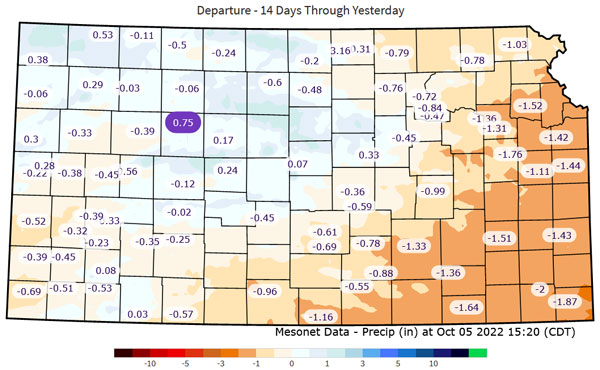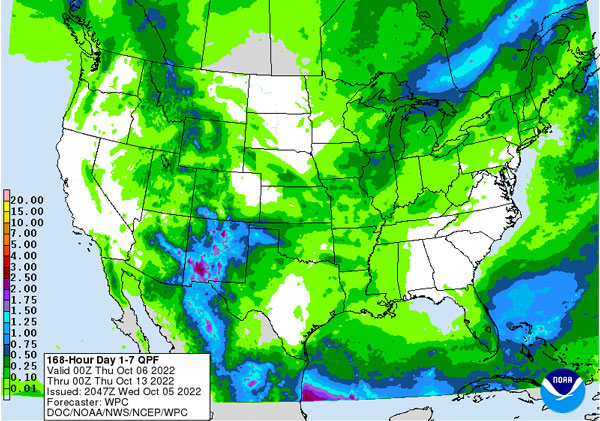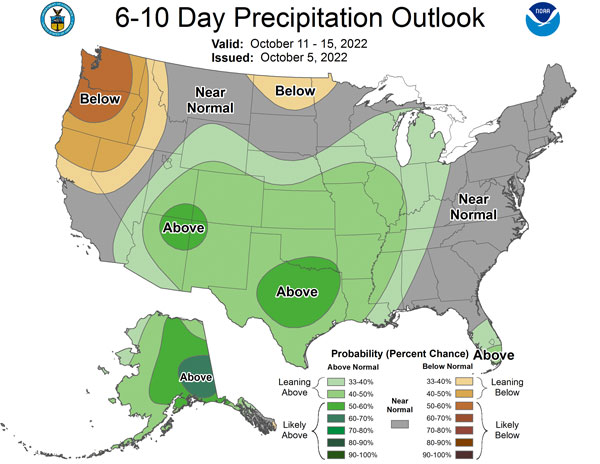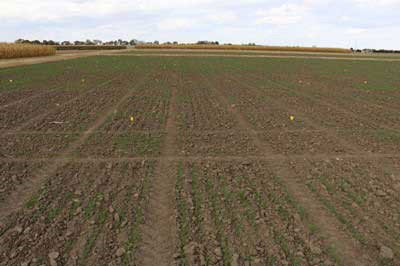Prolonged drought continues across Kansas. The state only received about half of the statewide average precipitation for September. A late-month precipitation event in north central Kansas saved the state from one of the driest Septembers on record. This event improved soil moisture conditions temporarily for the ones lucky enough to receive above-normal moisture (Figure 1). While this significantly bumped up soil moisture in northwest and north central Kansas, the benefits have rapidly diminished due to warm and breezy conditions. Over the last week, soil moisture has rapidly diminished with negative changes at the 4-inch (10-cm) depth (Figure 2). Areas with little soil moisture change over the last week are already completely dried out.

Figure 1. Departure from normal precipitation over the last two weeks, from September 21 to October 4, 2022. Map by the Kansas Mesonet.

Figure 2. Change in volumetric water content at the 4-inch soil depth (10 cm) over the last seven days, as of October 5, 2022. Map by the Kansas Mesonet.
Weather forecast
The next 7-day precipitation forecast for Kansas indicates that rainfall is expected to be minimal across the state (Figure 3). Totals are only expected to range from 0-0.25 inches which would fall short of the weekly normal precipitation for the second week of October ranging from 0.4 inches in the west to 0.9 inches in the southeast. The 6- to 10-day forecast favors increased probability of above-normal precipitation statewide (Figure 4). The forecast for the coming weeks is more uncertain than normal due to persisting drought and a pattern change (see the companion article on the 2022 Fall Weather Outlook in this eUpdate issue).

Figure 3. Weekly precipitation forecast as of October 5, 2022 by the National Weather Service Weather Prediction Center (NOAA). Precipitation probabilities in Kansas for the next 7 days range from 0.00 to 0.25” inches.

Figure 4. The 6- to 10-day precipitation forecast as of October 5, 2021 by the Climate Prediction Center, NOAA.
Wait for rain or continue with planting progress?
The current wheat-planted acreage in Kansas, according to the USDA-NASS crop progress report, was 30% as of October 2, 2022. This is behind the 5-year average of 39%. Likewise, only 6% of the crop has emerged so far (behind the 5-year term average of 17%).
The biggest question in growers’ minds at the moment is: Should I continue planting the crop, or should I wait for rain?
Each grower must consider his or her own situation to take this decision, as the rainfall distribution shown in Figure 1 is interpolated across weather stations and might not represent the reality for a few fields that were far from a given weather station.
Advantages of progressing with crop planting now is to take advantage of the available moisture where recent rainfall occurred (that is, where moisture is still available which is the case for some regions in north central Kansas), and also a good seed distribution in dryer soils where rainfall did not occur. In this situation, growers also have the opportunity to plant a large number of acres before it rains. However, if no rain occurs in the near future, the crop might not emerge until it rains later in the fall or even winter, delaying the “effective planting date” to whenever the rain actually occurs. Thus, at this point in time, growers should start to treat these fields as if they were sowing late, where increases in seeding rate and applications of in-furrow starter fertilizer are recommended. These might also be situations in which seed treatments can be beneficial, as the seeds will be exposed to weather in the fields for several days.
The worst-case scenario would include planting into a limited amount of moisture, just enough for emergence of some plants but not enough to maintain these seedlings after they emerge. This situation can result in uneven stands and high stand variability within the field (Figure 5), or even crop failure. Thus, if good moisture cannot be reached in about the top 1.5-2 inches of soil, growers would likely be better off sowing it shallower and waiting for rain.
From a regional perspective, we are either reaching the optimum planting window (north central Kansas) or we are already past the optimum planting window (northwest Kansas) for wheat. In these regions, if there is no moisture available for immediate emergence and growers decide to plant the crop, they should already start increasing seeding rates and adding more in-furrow phosphorus fertilizer to compensate for a late emergence. In south central and eastern Kansas, the optimum planting date is usually not until October 10-15, so there is still time to make this decision and the rain forecast is more favorable. In these cases, growers could still maintain their original seeding rate for optimal sowing time.
For more information on planting wheat into dry soils, please see a previous eUpdate article from September 15, 2022: https://eupdate.agronomy.ksu.edu/article_new/considerations-when-planting-wheat-into-dry-soil-512-1

Figure 5. Uneven wheat stands resultant from sowing into dry soils. Photo by Romulo Lollato, K-State Research and Extension.
Romulo Lollato, Wheat and Forages Specialist
lollato@ksu.edu
Christopher “Chip” Redmond, Kansas Mesonet Manager
christopherredmond@ksu.edu